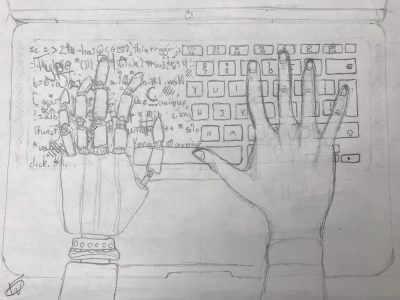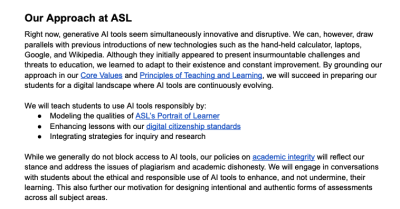
The recent rise in popularity of generative AI softwares, such as Chat GPT, has led to some students using these technologies to complete school assignments. As a result, the school has updated its academic integrity policies to include instances of students using generative AI as questions of academic integrity.
Generative AI is artificial intelligence software that can generate images, answers, essays, and more in response to a user’s prompts. Many types of AI exist, including Chat GPT, an artificial intelligence chatbot, and DALL-E, which generates images according to prompts.
To address this, the middle school administration created a document about the school’s policy on generative AI in education. The document outlines how the school plans to approach telling students about how and when it is appropriate to use AI and states that faculty members and the administration will, “Engage in conversations with students about the ethical and responsible use of AI tools to enhance, and not undermine, their learning.”
According to the policy, if teachers suspect students of submitting work created by or aided by AI, they may use AI checkers to confirm or deny their suspicions.
Furthermore, seventh-grade English teacher Mr. Talim Arab said that if a student were to turn in work that he thought may have been plagiarized from AI, he would talk to the student and see what is happening. “Academic integrity and being ethical are vital to being a writer. Therefore, writers must consider the implications of AI-generated writing.”
If the school suspects a student of submitted AI-generated writing for an assignment, the response would usually involve a meeting with the student, their parents, the teacher, and the administration. Mr. Peter Lutkoski, the middle school principal, said, “There would be conversations with the student and the teacher with their parents and a member of the administration so that we can try and find out what happened. The student would also be expected to redo the work, and depending on the circumstances, there may be other consequences.”
The middle school administration has been exploring ways to ensure all teachers understand how students can use artificial intelligence to complete work. Mr. Simon Plissi, the middle school laptop coordinator, said, “We’ve [faculty and TILM department] had meetings where this issue has popped up, and we’ve discussed it to make sure that the faculty are aware of the misuse of technology out there, particularly in schooling environments.”

Additionally, the school policy also includes guidance for teachers. It says that teachers should set clear expectations about when students should or should not use generative AI, connect the topic to the school’s core values, and inform students about AI detectors. The administration has also shared a list of websites about Chat GPT and how to discuss the boundaries around it with their children.
Many teachers have also talked to students about when it is appropriate to use generative AI. Eighth-grade English teacher Mr. Mike Boodey said that he told parents and students to refer to guidelines about Chat GPT. Mr. Boodey said, “We sent all the families guidelines and we’ve also told the students in class that we don’t want them using AI for these reasons, but it’s in our brains to think about how we could ues it going forward. So we’ve just been really blunt about it.”
The administration have also been planning panels with parents to discuss the school’s position on the issue. Mr. Lutkoski said, “We’ve been thinking about organizing parent meetings where we can ask and answer any questions about the issue.”
Most students agree that their peers should not use Chat GPT in general. Sixth-grade student Neha Garud said, “I believe that students shouldn’t use Chat GPT because it will not open the creative mind as they can simply get whatever they want without using their own brains.”
Garud also added that she believes students shouldn’t use Chat GPT because it does not always have reliable sources of information, so students should ask teachers, parents or search it up on a regular search engine instead.
However, other students think using Chat GPT or other AI tools is acceptable in certain circumstances. Seventh-grade student Taline Tendjoukian feels that if somebody just wanted an idea, it would be fine for as long as they didn’t copy everything down word for word since that would be plagiarism.
Mr. Boodey agrees and thinks that generative AI would also not be helpful for specific assignments. Mr. Boodey said, “The nature of the assignments we’re doing right now is that we’re looking for originality and creativity of ideas, and specific ways of crafting thoughts, and Chat tools like Chat GPT just don’t align with our assignment practices.”
In addition, certain teachers are also looking to use generative AI tools in lesson planning. Sixth-grade English teacher Ms. Jessie Twiest said, “As a teacher, I think that it could be really useful, but we still have to explore it to understand how to use it and its limits.”
Seventh-grade science teacher Mr. Rod Anderson is already looking for ways to stop students using Chat GPT. “I think if we use old-school pen and paper for our assignments, which is what we’re mostly doing right now, it would be really hard to use these technologies.”
Also, many students and teachers have been using Grammarly, which is another form of artificial intelligence.
Nevertheless, as new technologies advance, the school will also evolve its policies. Mr. Lutkoski said, “As new technologies emerge, or other AI tools become available, we will monitor those and update our guidance if necessary.”
Even so, the school remains committed to maintaining students’ learning and development as one of its top priorities. Mr. Lutkoski said, “When a student submits something that’s not their work, it creates a barrier to their learning because the teacher is not even giving feedback to the student, and the student is no longer representing who they are and what they can do.”
Editor’s note: This article was named as the News Story of the Year by the NSPA at an awards ceremony in Boston, Massachusetts on November 4, 2023
